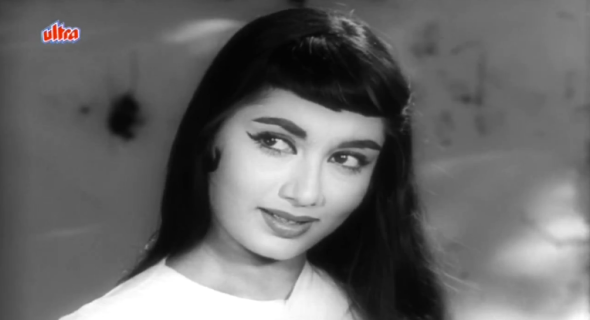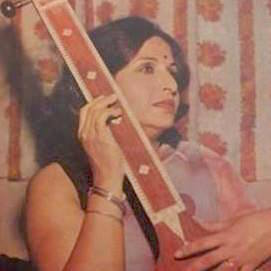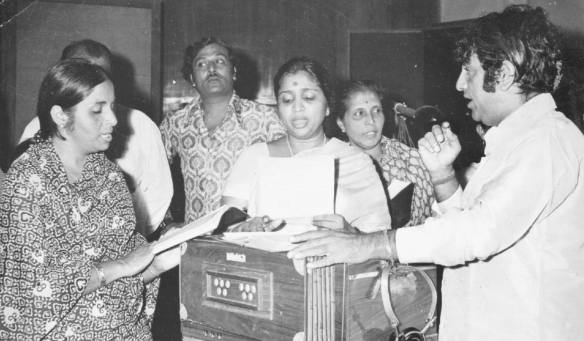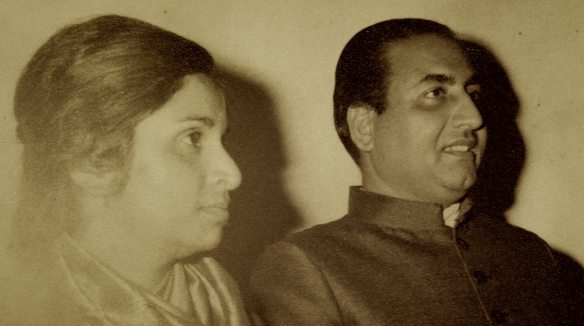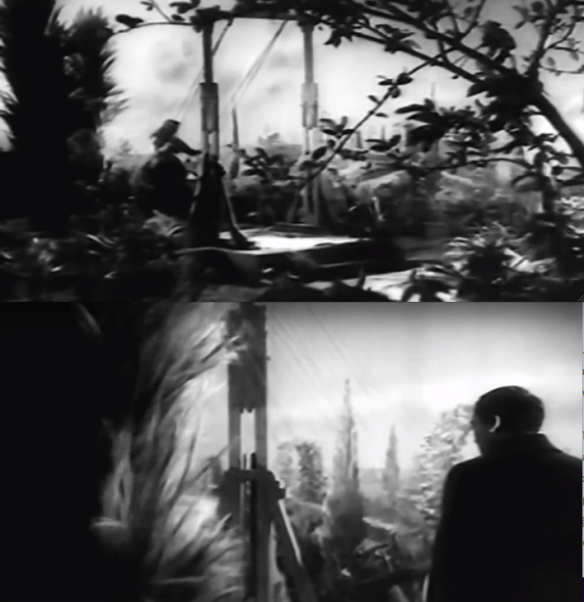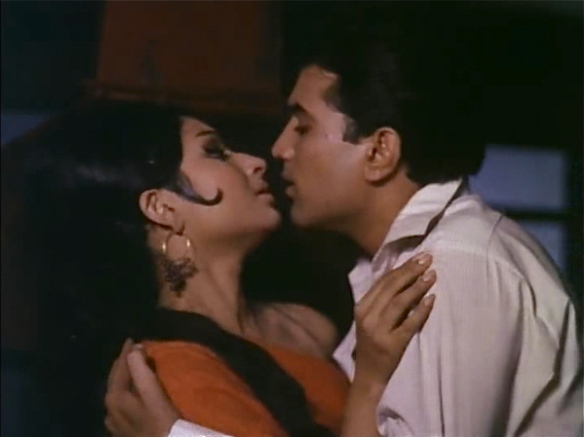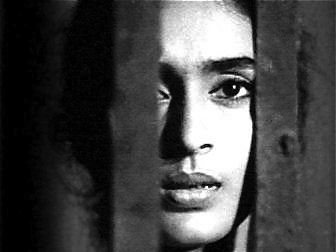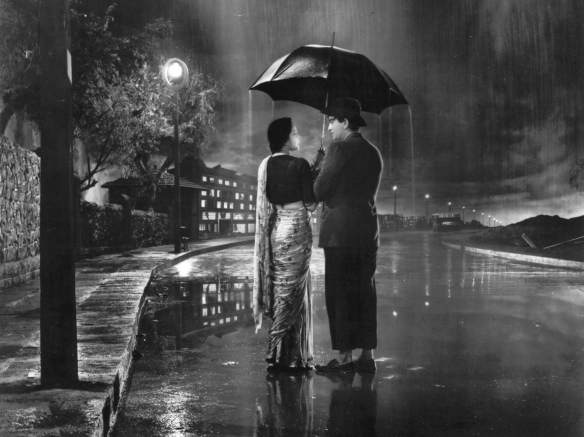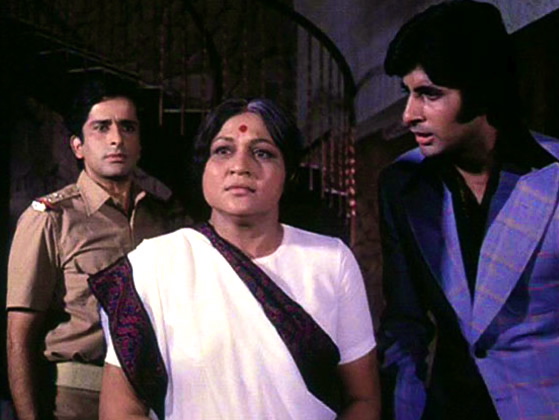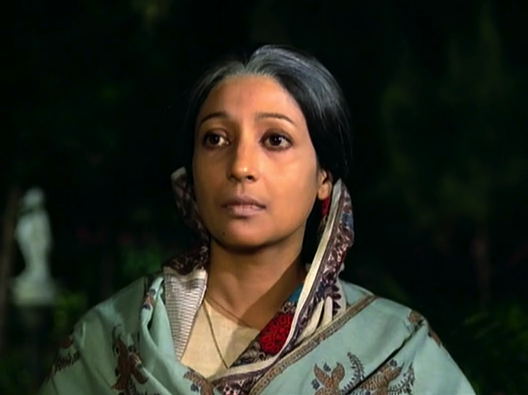Happy Halloween to our readers! What better way to celebrate with a classic ghost song featuring Lata Mangeshkar’s spooky vocals, Sadhana’s haunting beauty, and Madan Mohan’s soul-stirring composition? In the spirit of Halloween, we are sharing the lyrics and English translation to nainaa barse rimjhim rimjhim from Raj Khosla’s suspense thriller Woh Kaun Thi? (1964).
In a previous post, we have discussed how Woh Kaun Thi? is the quintessential example of film noir being adapted for vintage Hindi cinema. In this film, Dr. Anand (Manoj Kumar) encounters a mysterious woman (Sadhana) on a stormy night and offers to give her a ride in his car. After she makes a strange request to be dropped off at a local cemetery, he hears this woman sing the first part of nainaa barse – a song that continues to haunt him at various points throughout the film. Later in the movie, Dr. Anand is called to see a patient in an old mansion that is rumored to be haunted. When he arrives at this mansion, the patient has already died and she appears to be the same woman that he encountered on the stormy night. In an even more strange turn of events, Dr. Anand’s fiancee is murdered suddenly by a cyanide injection. To alleviate his grief and loneliness, Dr. Anand is set up by his mother to his marry a new woman named Sandhya. Much to his surprise, Dr. Anand finds on his wedding night that his new wife looks exactly like the supposedly dead woman he gave a ride to in the film’s opening scene! Like Dr. Anand, the audience is left confused as they grapple with the film’s eponymous question: Woh kaun thi? Who was she?
Throughout her career, Lata Mangeshkar earned a reputation for her haunting renditions of ghost songs in films. Some of her most influential and beautiful hits are used as ghost songs in their respective movies: aayegaa aanevaalaa from Mahal (1949), tuu jahaa.n jahaa.n chalegaa from Mera Saaya (1966), kahii.n diip jale kahii.n dil from Bees Saal Baad (1962), and gumnaam hai koii from Gumnaam (1965). In an interview for her 80th birthday, the melody queen humorously remarks about her career: mai.n ne sab se zyaadaa gaanaa gaaye hai.n bhuuto.n ke (I have sung the most songs for ghosts!).
An interesting and apt anecdote: when this song was being filmed in Kufri (near Shimla), Lata had not yet had the opportunity to record the song in the studio. Much to the surprise of the crowd that had gathered to watch the filming, actress Sadhana shot her scenes by lip-syncing to a version of this song rendered by music director Madan Mohan himself – perhaps a bit creepy but also a rare treat!
Did you know that Woh Kaun Thi? was inspired by a British play called The Woman In White (1859) written by Wilkie Collins? Raj Khosla’s mentor Guru Dutt had attempted to create a film based on the same story a few years earlier in 1959. He abandoned this project entitled Raaz in which he was supposed to play the male lead while Waheeda Rehman played the female lead. Interestingly, this film was supposed to have been R.D. Burman’s debut as a solo music director.
-Mr. 55
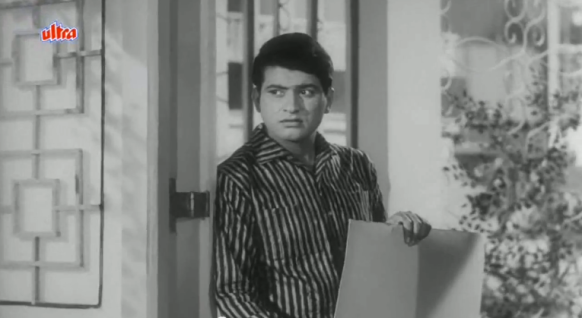
Manoj Kumar plays a confused doctor who is recurrently haunted by a mysterious woman and her song in Woh Kaun Thi? (1964)
Naina Barse Rimjhim Rimjhim (Version 1): Lyrics and Translation
nainaa barse rimjhim rimjhim
My eyes shed tears, drop by drop,
piyaa tore aavan kii aas
in hopes of your return, my beloved.
nainaa barse, barse, barse
My eyes shed tears.
yeh laakho.n gham, yeh tanhaayii
Thousands of sorrows and this solitiude
muhabbat kii yeh rusvaayii
are all part of love’s disgrace.
kaTii aisii kaii raate.n
I have spent several such nights
na tum aaye na maut aayii
where neither you came to me, nor my death.
yeh bi.ndiyaa kaa taaraa
The star of my beauty spot
jaise ho a.ngaaraa
burns brightly like an ember.
mahandii mere haatho.n kii udaas
Even the henna on my hands is sullen.
nainaa barse rimjhim rimjhim
My eyes shed tears, drop by drop,
piyaa tore aavan kii aas
in hopes of your return, my beloved.
nainaa barse, barse, barse
My eyes shed tears.
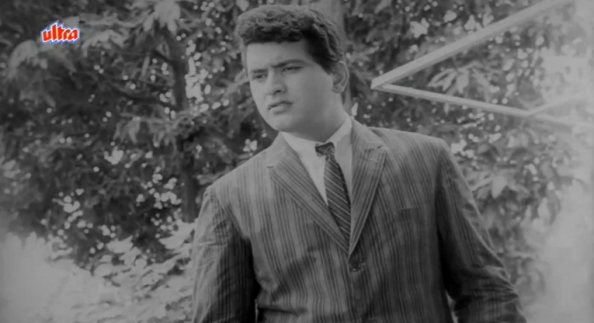
Manoj Kumar’s restrained and understated performance falls short in comparison to Sadhana’s dynamic portrayal of the leading character in Woh Kaun Thi? (1964).
Naina Barse Rimjhim Rimjhim (Version 2): Lyrics and Translation
nainaa barse rimjhim rimjhim
My eyes shed tears, drop by drop,
piyaa tore aavan kii aas
in hopes of your return, my beloved.
nainaa barse, barse, barse
My eyes shed tears.
adhuuraa huu.n mai.n afsaanaa
I am an incomplete story.
jo yaad aauu.n chale aanaa
When you remember me, come back to me.
meraa jo haal hai tujh bin
The state that I am in without you,
voh aa kar dekhte jaanaa
come to me and see it for yourself.
bhiigii bhiigii palke.n
My eyelashes are moist,
chham-chham aa.nsuu chhalke.n
as my tears drip, sounding like the jingle of an anklet.
khoyii khoyii aa.nkhe.n hai.n udaas
My eyes are lost and sullen.
nainaa barse rimjhim rimjhim
My eyes shed tears, drop by drop,
piyaa tore aavan kii aas
in hopes of your return, my beloved.
nainaa barse, barse, barse
My eyes shed tears.

Sadhana’s dashing beauty shines against the backdrop of Shimla in the Himalayas in Woh Kaun Thi? (1964)
Naina Barse Rimjhim Rimjhim (Version 3): Lyrics and Translation
nainaa barse rimjhim rimjhim
My eyes shed tears, drop by drop,
piyaa tore aavan kii aas
in hopes of your return, my beloved.
nainaa barse, barse, barse
My eyes shed tears.
voh din merii nigaaho.n me.n
Those days remain in my eyes.
voh yaade.n merii aaho.n me.n
Those memories remain in my sighs.
yeh dil ab tak bhaTaktaa hai
This heart still wanders
terii ulfat kii raaho.n me.n
along the paths of your love.
suunii suunii raahe.n, sahmii sahmii baahe.n
Along those empty paths, with my nervous arms,
aan.kho.n me.n hai barso.n kii pyaas
my eyes carry a thirst unslaked for years.
nazar tujh bin machaltii hai
My sight wavers without you.
muhabbat haath maltii hai
My love repents in desperation.
chalaa aa mere parvaane
Please come to me, my moth.
vafaa kii shamaa jaltii hai
The candle of faithfulness still burns brightly.
o mere hamraahii, phirtii huu.n ghabraayii
Oh, my soulmate! I wander about afraid.
jahaa.n bhii hai, aa jaa mere paas
Wherever you are, please come to me.
nainaa barse rimjhim rimjhim
My eyes shed tears, drop by drop,
piyaa tore aavan kii aas
in hopes of your return, my beloved.
nainaa barse, barse, barse
My eyes shed tears.
Glossary
nainaa: eyes; barasnaa: to rain; rimjhim: onomatopoeia for the dripping noise of rain; aavan: return, arrival; aas: hope; adhuuraa: incomplete; afsaanaa: story; haal: state, condition; palak: eyelid, eyelash; chham-chham: onomatopoeia for the jingling noise of an anklet; chhalaknaa: to drip; udaas: sullen, gloomy; tanhaayii: solitude; rusvaayii: disgrace; maut: death; bi.ndiyaa: beauty spot; angaaraa: cinder, ember; mahandii: henna, nigaah: eyes; aah: sigh; sahmaa: nervous; baras: year; pyaas: thirst; nazar: glance, sight; machalnaa: to waver; haath malnaa: to repent; parvaanaa: moth; vafaa: faithfulness; shamaa: candle; hamraahii: soulmate, companion; phirnaa: to wander about; ghabraayaa: afraid.


